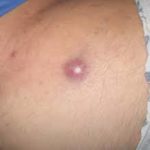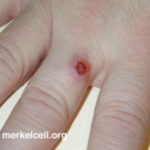November 16, 2017 | Stephen Fine, Founder and President
Merkel Cell Carcinoma
Our skin cancer blog posts are nearly always focused on some variant of the potentially lethal melanoma. This post, however, will highlight an affliction much rarer and even deadlier- Merkel Cell Carcinoma (MCC).
Each type of skin cancer carries its own method of development and level of risk. One fact that remains consistent between all of them, however, is that the best chance for a successful outcome is the speed of diagnosis. Melanoma, the worst form of skin cancer, goes from nearly a 100% cure rate if caught earlier enough, to a painfully fatal disease if caught too late. But Merkel Cell Carcinoma is even more dangerous than melanoma, because its speed of growth is much faster.
When a person first notices a skin growth that turns out to be melanoma, there may still be time to stop it in its tracks. When he or she first glimpses MCC, it may already be too late. That’s why the focus should be on picking up on its warning signs, and early self-detection. Doing so will be effective in helping to stop MCC before it has a chance to really get started.
Patients should not wait for regular check-ups. Most doctors don’t even bother checking at all for skin cancer during routine exams unless they’re asked to, they notice something obvious, or there’s some specific reason to do so.
What to Look for
MCC typically presents as a painless skin growth that can be red, blue, purple or even match the color of the surrounding skin. The latter makes it much easier for people to make the crucial error of dismissing MCC as nothing more than a normal skin blemish.
Please note that MCC can easily be mistaken for nodular melanoma, or even a benign melanoma mimic.
AEIOU
For decades, dermatologists have touted the ABCD mnemonic device to remind the public how to look for melanoma during monthly skin self-exams. MCC has a similar, lesser known device, too: AEIOU, the 5 vowels in our alphabet placed in alphabetical order. They stand for: Asymptomatic, Expanding Rapidly, Immune Compromised, Over 50 & UV-Exposed Fair Skin.
Risk Factors
MCC primarily develops in people who are at least 50 years old, those who’ve incurred significant sun exposure and persons whose immune systems have been compromised; such as that which occurs after contracting HIV. Otherwise, MCC takes a similar path, albeit much quicker, to the one melanoma does.
If allowed to metastasize and progress away from the skin, it will head for lymph nodes and other organs such as the lungs, brain, liver and/or bones. Upon arrival it will launch an attack that is difficult for the body, even with significant medical treatment, to successfully defend. If the treatment is unsuccessful, the impact of MCC will most likely result in the patient’s death.
These 3 photographs of Merkel Cell Carcinoma show just how nondescript this disease can look:



Additional source articles: Mayoclinic.org, Curetoday.com (Fall 2017, Vol 16, No. 4, author Tara Haelle), Mdedge.com
